Full-Length 6th Grade IAR Math Practice Test
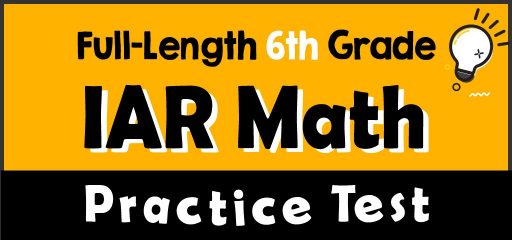
Important factors play a role in increasing students’ readiness before the 6th Grade IAR Math test. One of the most important factors that will assess the condition of 6th-grade students and their readiness is the use of the Full-Length 6th Grade IAR Math Practice Test.
Full-Length 6th Grade IAR Math Practice Test has many benefits and helps 6th-grade students in various aspects of assessment. These full-length tests are designed to be as similar as possible to the 6th Grade IAR Math test.
To use this full-length 6th-grade IAR math practice test, try to create the condition of a real test for yourself. Do not ignore test time limits and use scratch paper, pencil, timer, and calculator.
There is not much way until success! Do not miss the Full-Length 6th Grade IAR Math Practice Test to simulate the test day! When done, score your tests using the answer keys.
Good luck!
The Absolute Best Book to Ace the IAR Math Test
Time to refine your Math skill with a practice test
Take a REAL 6th Grade IAR Mathematics test to simulate the test day experience. After you’ve finished, score your test using the answer key.
Before You Start
- You’ll need a pencil, a calculator, and a timer to take the test.
- It’s okay to guess. You won’t lose any points if you’re wrong. So be sure to answer every question.
- After you’ve finished the test, review the answer key to see where you went wrong.
- Calculators are permitted for the 6th Grade IAR Math Test.
- Use the answer sheet provided to record your answers.
- The 6th Grade IAR Mathematics test contains a formula sheet, which displays formulas relating to geometric measurement and certain algebra concepts. Formulas are provided to test-takers so that they may focus on the application, rather than the memorization, of formulas.
- For each multiple-choice question, there are five possible answers. Choose which one is best.
Good Luck!
Best 6th Grade IAR Math Prep Resource
Common Core Math Exercise Book for Grade 6 Student Workbook and Two Realistic Common Core Math Tests
6th Grade IAR Math Practice Test
1- What is the value of the expression \(5(4x-3y)-7y^2\), when \(x=2\) and \(y=-3\) ?
A. \(15\)
B. \(22\)
C. \(36\)
D. \(42\)
2- Martin earns \($18\) an hour. Which of the following inequalities represents the amount of time Martin needs to work per day to earn at least \($78\) per day?
A. \(18-t≥78\)
B. \(18+t≤78\)
C. \(18t≥78\)
D. \(18t≤78\)
3- \((108-(3×9))÷9\) is equivalent to …
A. \((\frac{2}{5}+\frac{7}{8}) ×3\)
B. \(9^3÷81\)
C. \((5×5×5) ÷\frac{9}{2}\)
D. \((2×2×5)÷(3×4)\)
4- The ratio of boys to girls in a school is \(3∶5\). If there are \(240\) students in the school, how many boys are in the school?
A. \(60\)
B. \(90\)
C. \(120\)
D. \(150\)
5- Anita’s trick–or–treat bag contains \(9\) pieces of chocolate, \(15\) suckers, \(14\) pieces of gum, and \(16\) pieces of licorice. If she randomly pulls a piece of candy from her bag, what is the probability of her pulling out a piece of chocolate?
A. \(\frac{1}{6}\)
B. \(\frac{5}{7}\)
C. \(\frac{3}{4}\)
D. \(\frac{5}{6}\)
6- Which of the following lists shows the fractions in order from greatest to least? \(\frac{3}{4}, \frac{2}{3}, \frac{4}{5}, \frac{7}{9} ,\)
A. \(\frac{4}{5},\frac{7}{9},\frac{3}{4},\frac{2}{3}\)
B. \(\frac{3}{4},\frac{7}{9},\frac{4}{5},\frac{2}{3}\)
C. \(\frac{7}{9},\frac{3}{4},\frac{2}{3},\frac{4}{5}\)
D. \(\frac{2}{3},\frac{3}{4},\frac{7}{9},\frac{4}{5}\)
7- The area of a rectangular yard is \(84\) square meters. What is its width if its length is 14 meters?
A. \(5\) meters
B. \(6\) meters
C. \(7\) meters
D. \(8\) meters
8- Which statement about \(4\) multiplied by \(\frac{5}{16}\) must be true?
A. The product is greater than \(2\)
B. The product is between \(1\) and \(2\)
C. The product is equal to \(\frac{3}{8}\)
D. The product is equal to \(2^2\)
9- In the following rectangle, which statement is false?
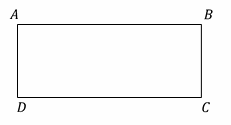
A. \(AD\) is parallel to \(BC\).
B. The measure of the sum of all the angles equals \(180^\circ\).
C. Length of \(AB\) equal to length \(DC\).
D. \(AB\) is perpendicular to \(AD\).
10- Round \(\frac{824}{17}\) to the nearest tenth.
A. \(48\)
B. \(48.4\)
C. \(48.5\)
D. \(49\)
11- What is the missing price factor of number \(588\)\(?\) \(588=2^2×3×\)…
12- If the area of the following trapezoid is equal to \(A\), which equation represents \(x\)?
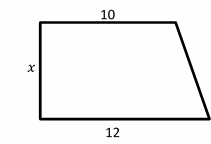
A. \(x=\frac{11}{A}\)
B. \(x=\frac{A}{11}\)
C. \(x=A-11\)
D. \(x=A+11\)
13- By what factor did the number below change from the first to the fourth number? \(8 ,72,648,5832\)
A. \(6\)
B. \(9\)
C. \(12\)
D. \(16\)
14- \(234\) is equal to …
A. \(13-(3×6)+(7×(-6))\)
B. \((\frac{25}{400})+(\frac{7}{50})\)
C. \(((22×\frac{30}{6})-(7×\frac{144}{12}))×\frac{18}{2}\)
D. \(\frac{6}{24}+\frac{12}{36}-50\)
15- A car costing \($240\) is discounted \(16\%\). Which of the following expressions can be used to find the selling price of the car?
A. \((450)(0.16)\)
B. \(450-(450×0.84)\)
C. \((450)(0.16)\)
D. \(450-(450×0.16)\)
16- Mr. Jones saves \($1,400\) out of his monthly family income of \($11,900\). What fractional part of his income does Mr. Jones save?
A. \(\frac{2}{17}\)
B. \(\frac{5}{17}\)
C. \(\frac{7}{17}\)
D. \(\frac{9}{17}\)
17- Nicolas wrote an integer. The opposite of Nicolas’s integer is \(-25\). Which of the following statements about Nicolas’s integer must be true?
I. The integer is \(25\).
II. The absolute value of the integer is \(-25\).
III. The integer is \(-25\).
IV. The absolute value of the integer is \(25\).
A. I and II
B. II and III
C. I and IV
D. III and IV
18- What is the volume of a box with the following dimensions?
Height \(= 7 cm\) , Width \(= 4 cm\), Length \(= 12 cm\)
A. \(312\space cm^3\)
B. \(336\space cm^3\)
C. \(362\space cm^3\)
D. \(395\space cm^3\)
19- The distance between the two cities is \(33,759\) feet. What is the distance between the two cities in yards?
A. \(9,570\space yd\)
B. \(10,920\space yd\)
C. \(11,253\space yd\)
D. \(13,617\space yd\)
20- A chemical solution contains \(16\%\) alcohol. If there are \(38 ml\) of alcohol, what is the volume of the solution?
A. \(195\space ml\)
B. \(237.5\space ml\)
C. \(369\space ml\)
D. \(452.5\space ml\)
21- Which expression is equivalent to \((-2)(9x-8)\)?
A. \(-16x+18\)
B. \(16x-18\)
C. \(-18x+16\)
D. \(18x+16\)
22- A bottle contains \(576\) fluid ounces of special chemical solutions. How many pints of chemical solution does the bottle contain?
A. \(18\space pt\)
B. \(22\space pt\)
C. \(30\space pt\)
D. \(36\space pt\)
23- Slove: \(120 kg =\) … ?
A. \(1,200\space mg\)
B. \(120,000\space mg\)
C. \(1,200,000\space mg\)
D. \(120,000,000\space mg\)
24- Calculate the approximate area of the following circle? (the diameter is \(14\))
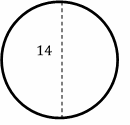
A. \(97.5\)
B. \(114.8\)
C. \(153.9\)
D. \(216.2\)
25- The following graph shows the mark of six students in mathematics. What is the mean (average) of the marks?
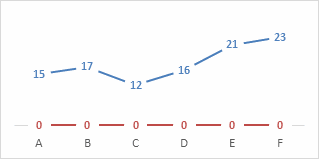
A. \(16.5\)
B. \(17.3\)
C. \(18.2\)
D. \(19\)
26- What is the lowest common multiple of \(18\) and \(24\)?
A. \(18\)
B. \(48\)
C. \(72\)
D. \(96\)
27- Which ordered pair describes point \(P\) that is shown below?
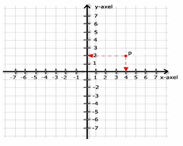
A. \((2,4)\)
B. \((4,2)\)
C. \((4, -2)\)
D. \((-2,4)\)
28- What is the ratio between α and β(\(\frac{α}{β}\)) in the following shape?

A. \(\frac{5}{12}\)
B. \(\frac{11}{25}\)
C. \(\frac{5}{12}\)
D. \(\frac{25}{11}\)
29- Find the opposite of the numbers \((-4,7)\).
A. \(\frac{1}{4},-7\)
B. \(-4,\frac{1}{7}\)
C. \(4,-7\)
D. \(-4,-7\)
30- What is the value of \(x\) in the following equation: \(16=-129+x\)
A. \(85\)
B. \(-85\)
C. \(145\)
D. \(-145\)
31- Which of the following graphs represents the following inequality?
\(-5<2x+7≤3\)
A.

B.

C.

D.

32- Which of the following statements is correct, according to the graph below?
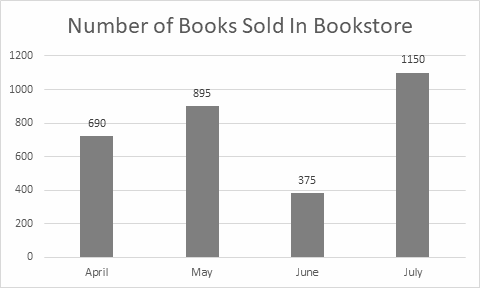
A. The number of books sold in April was twice the number of books sold in July.
B. The number of books sold in July was more than one-third of the number of books sold in May.
C. The number of books sold in June was less than one-third of the number of books sold in April.
D. The number of books sold in July was equal to the number of books sold in April plus the number of books sold in June
33- To produce a special concrete, for every \(17 kg\) of cement, \(6\) liters of water is required. Which of the following ratios is the same as the ratio of cement to liters of water?
A. \(78∶ 34\)
B. \(51∶ 17\)
C. \(49∶ 17\)
D. \(63∶ 16\)
34- An integer is chosen at random from \(9\) to \(15\). Find the probability of not selecting a composite number.
A. \(\frac{1}{3}\)
B. \(\frac{4}{5}\)
C. \(\frac{3}{7}\)
D. \(\frac{2}{7}\)
35- On a certain bookshelf of a library, there are \(20\) biology books, \(59\) history books, and \(36\) language books. What is the ratio of the number of biology books to the total number of books on this bookshelf?
A. \(\frac{4}{23}\)
B. \(\frac{3}{17}\)
C. \(\frac{2}{15}\)
D. \(\frac{4}{15}\)
36- Which of the following is the correct statement?
A. \(\frac{5}{8}>0.8\)
B. \(23\%<\frac{2}{3}\)
C. \(8<\frac{18}{3}\)
D. \(\frac{7}{9}<0.6\)
37- Daniel is \(38\) years old, twice as old as Henry. How old is Henry?
A. \(19\) years old
B. \(27\) years old
C. \(62\) years old
D. \(76\) years old
38- A waiter earned a \(38\) percent tip. What decimal is equivalent to \(38\) percent?
39- Which of the following statements can be used for the following inequality? \(\frac{9}{x}≤19\)
A. Sara placed \(x\) pens among \(19\) friends and each friend received fewer than \(9\) pens.
B. Sara placed \(9\) pens among \(x\) friends and each friend received at most \(19\) pens.
C. Sara placed \(x\) pens among 9 friends and each friend received more than \(19\) pens.
D. Sara placed \(x\) pens among 9 friends and each friend received fewer than \(19\) pens
40- If the area of the following rectangular \(ABCD\) is \(180\), and \(E\) is the midpoint of \(AB\), what is the area of the triangle \(ADE\)?
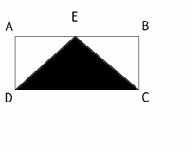
A. \(35\)
B. \(40\)
C. \(45\)
D. \(50\)
The Most Comprehensive Review for 6th-Grade Students
Common Core Math Exercise Book for Grade 6 Student Workbook and Two Realistic Common Core Math Tests
Answers and Explanations
Related to This Article
More math articles
- Half-Angle Identities
- Stem –and–Leaf Plots
- HL Congruence: The Special Case of Right Triangles
- The Ultimate 6th Grade SOL Math Course (+FREE Worksheets)
- Top 10 Websites to Learn About Scholarships, Federal Aid, and Student Funding
- FREE 7th Grade ACT Aspire Math Practice Test
- 8th Grade ACT Aspire Math Practice Test Questions
- ACT Math FREE Sample Practice Questions
- How to Ace the GRE Quant Section?
- Riemann Sums Made Easy: Step-by-Step Tutorial
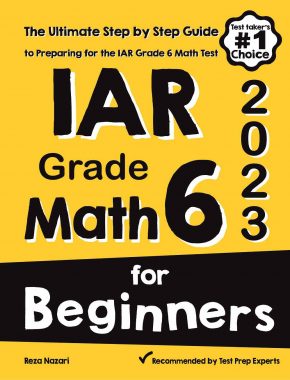
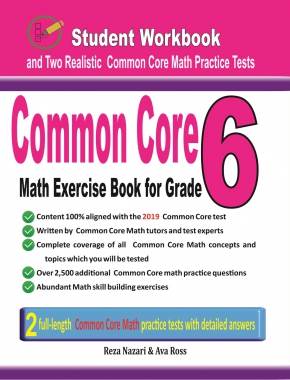
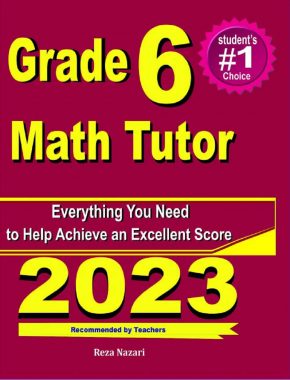
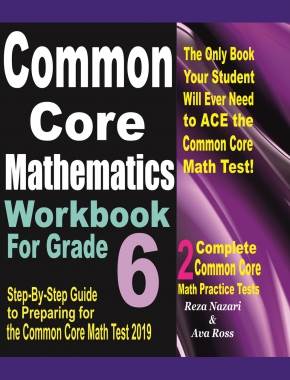

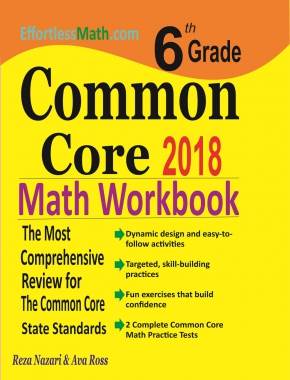
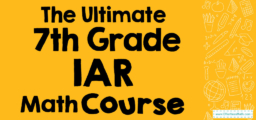
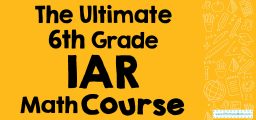
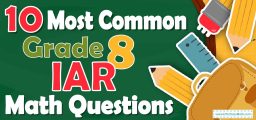
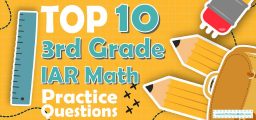
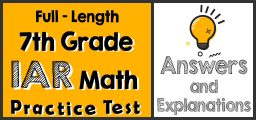
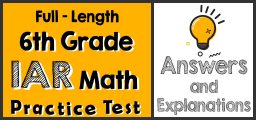
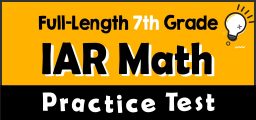
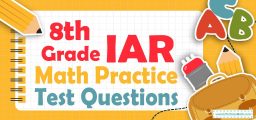
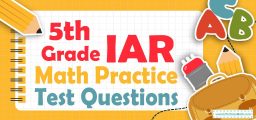
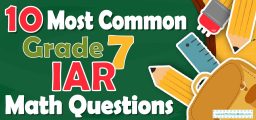
What people say about "Full-Length 6th Grade IAR Math Practice Test - Effortless Math: We Help Students Learn to LOVE Mathematics"?
No one replied yet.